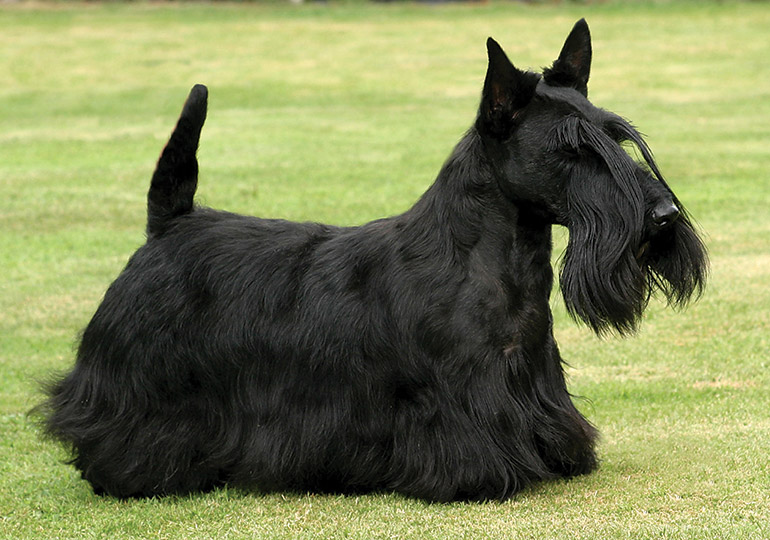Scottish Terrier
Breed Details
Size:
Exercise Requirements:
Grooming Requirements:
8-10 kg (approx)
12-15 years (approx)

Appearance
The Scottish Terrier is a small, compact, short-legged, sturdily-built terrier of good bone and substance. They have a hard, wiry, weather-resistant coat and a thick-set, cobby body which is hung between short, heavy legs. These characteristics, joined with his very special keen, piercing, "varminty" expression, and his erect ears and tail are salient features of the breed. The eyes should be small, bright, piercing, and almond-shaped not round. Allowable colours Black, wheaten, or brindle of any shade. The ears should be small, prick, set well up on the skull, and pointed, but never cut. They should be covered with short velvety hair.
History
The Scottie is among a cadre of "highland terriers" hailing from Scotland, alongside the Skye, Dandie Dinmont, Cairn, and West Highland White breeds. The Scottish terrier is an ancient breed documented as a fearless fox hunter as early as the 1400s. Nicknamed "The Diehard" for his tenacious nature, the Scottish terrier originally was a working dog that routed rats, and tracked fox, badger, and other small prey. Highly prized for his loyalty, intelligence, and energy, the iconic Scottie left the fields and farms to become a companion to royalty and presidents.
King James VI of Scotland loved the Scottish terrier, and his enthusiasm helped to popularize the breed during the 17th century.
Temperament
All Terriers have self-reliance about them, but the Scottie is more independent by nature than most other Terriers are. This can be a problem if you don't know how to handle this type of dog. The ideal Scottish Terrier owner will be able to establish himself as the leader of the pack and be consistent in his expectations. The Scottie working style has been described as efficient and businesslike, and their aloofness toward strangers makes them excellent watchdogs. Their hunting instinct remains strong, Scotties are known to be cantankerous around other dogs. This bold and clever Scotsman enjoys brisk walks and upbeat play. You'll want to make sure to socialize your young Scottie early and often to keep him from thinking of everyone he meets as a danger to his family. If not properly socialized, the naturally discriminatory Scottish Terrier temperament can make him overly suspicious of anyone who enters the house.
Care/Grooming
Scottish Terriers require regularly scheduled grooming. They are a dual-coated breed, with a harsh, wiry outer layer and dense, soft undercoat. Ideally, they are hand stripped. This should be started when they are young puppies so they get used to the process. Once a month would be best once the coat is started, but they can be worked on weekly.
With clipping, you will eventually lose the correct harsh texture, as the undercoat will take over once the cutting process is begun.

